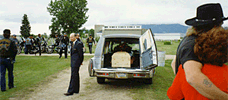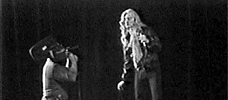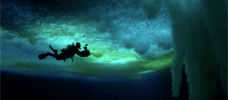Reviews
Jay Delaney
USA, 2008
Credits
Review by Katherine Follett
Posted on 30 May 2008
Source 35mm print
Related articles
Reviews Not Your Typical Bigfoot Movie by Victoria
Categories The 2008 Independent Film Festival of Boston
I fully expected that Not Your Typical Bigfoot Movie would be, in fact, typical. Not that I’ve seen thousands of Bigfoot movies (Harry and the Hendersons being the only one that comes to mind), but I have seen plenty of documentaries about goofy eccentrics and their hopelessly silly passions. It didn’t help that it was the last film I saw at the IFFB, and that several other documentaries had that half-interested, half-condescending tone that often permeates “quirky” nonfiction films. So when the film actually did live up to its title, when it treated its subjects with an almost unheard of dignity, I was profoundly grateful, and felt indebted to filmmakers who managed to make a respectful, empathetic, and deeply moving film about people who are almost universally mocked by mainstream culture.
The film concerns the lives of Dallas Gilbert and Wayne Burton, two “Bigfoot researchers” from rust-belt Pennsylvania. Even without the whole Sasquatch thing, these two men are already prime snickering material. They most definitely come from the part of Pennsylvania that some jokingly refer to as the “Alabama” between Philly and Pittsburgh. They’re aging, working-class, and poor. Dallas is missing most of his teeth. They live in ramshackle little wood-frame houses in a nowhere town. And as the documentary begins, it seems that there’s no way to avoid making fun of their primary passion in life: Bigfoot research. Their photos of “Bigfoot” are obviously no better than shadows. Their web sites are primitive and scream “CRACKPOT” in 16-point yellow Comic Sans. They believe without question the idea that the American east is crawling with hundreds of humanoid creatures heretofore unknown to science. The filmmakers face an incredible challenge in taking this patently ridiculous subject and turning it into a respectful film about real people.
Within the first few scenes, the filmmakers begin to strip away the silliness and bring out the humanity in Wayne and Dallas. They show photos of the men in their youth, describe their wives and families, and give us a sense of their community, their connections, and their senses of humor. This context immediately takes us out of the quixotic world of “Bigfoot” and into the recognizable - and very complicated - human world. Wayne, through the halting speech of a man who has been told his entire life he is stupid and intellectually worthless, describes how his youthful physical anger would often turn inward, culminating in a suicide attempt. Dallas quietly mourns the loss of one of his closest friends - a fellow Bigfoot researcher - who was recently the victim of a heart attack. These glimpses of Wayne and Dallas’s lives make it nearly impossible for the viewer to continue laughing at them. Their pain and vulnerability are immediately touching. This background also provides some very compelling reasons why these men are willing to devote an enormous amount of time and money on something as initially stupid-sounding as Bigfoot research.
Throughout the film, director Jay Delaney refrains from commenting directly on the existence of Bigfoot itself, focusing purely on the lives of the men. This is not, in fact, a movie about Bigfoot, but about people. To question the existence of Bigfoot in this film would be like questioning the existence of Allah in a documentary about Moslems. It would be both insulting and beside the point. Dallas seems to search for Bigfoot not so much to prove to the world that it exists, but to commune with what he views as another kind of soul. He speaks to the “Bigfoots” using snippets of Native American phrases that sound like mantras or prayers. He says he does not see or hear Bigfoot so much as feel its presence in his heart. And when he devotes his life to the pursuit of the creature, it is obviously not a hoax, not a quixotic folly, but a search for connection with something larger than himself. Wayne seems to search for the creature in order to be validated, to accomplish something notable, to achieve the success that has seemed unattainable since he felt compelled to give up on high school years ago. Very simply, Dallas and Wayne have very little left in their lives. Dallas is retired and his children have moved away. Wayne is divorced and very nearly unemployed. Neither has much money or opportunity. Beauty, soulfulness, and spiritual wonder are hard to come by in the slowly crumbling economy and social world around them. What they do have is time together in the woods, searching for glimpses of another world. And when they “find” these creatures, the director doesn’t mock them or even question them, but portrays the buoying effect that Bigfoot has on these men and their understanding of the possibilities of the world. You don’t have to believe in Bigfoot to understand why this belief is valuable, even crucial, to Wayne and Dallas.
Their friendship is tested when Wayne is invited to speak on a satellite radio show on occult and conspiracy theories. He’s coached by a fellow researcher to call an old photograph “recent,” but when questioned, he slips and reveals the false chronology. The radio show declares Wayne and Dallas’ work a “hoax,” leaving them basically pariahs in the world of Bigfoot researchers. While neither man will admit that the mistake has damaged their friendship, it obviously leaves a wound. The cameras continue to follow Wayne and Dallas over the following months as they go through the awkward and mostly unspoken process of patching up the damage. Things don’t quite smooth out until their dignity and the validity of their lives is suddenly confronted from the outside.
The pair gets a visit from a big-time Bigfoot researcher named Tom. This event is one of the few times when the sheer ridiculousness of the Bigfoot quest becomes apparent. Had the documentary focused on Tom, I would have been happy to see the filmmakers mock him and his silly schemes. Tom comes bearing all the obvious signs of status. He’s well known and well respected in the fringe (if established) world of Bigfoot researchers. He’s educated. He’s well off. He doesn’t have an accent. And he clearly sees Dallas and Wayne as small-time yokels. Tom and the pair go out in the woods and play some recorded sounds to try to attract a Bigfoot (Tom’s sounds being quite possibly the most aurally assaultive noises I’ve ever heard). When they hear what they interpret as a response, Dallas begins chanting his Indian mantra. “Shut up!” hisses Tom, and declares he’ll have to ditch these small-timers so he can come back and get some real work done. Though the filmmakers refrain from comment, the response is obvious—how can Dallas be doing it wrong when nobody is actually doing anything? When this is all imaginary? By insisting that there’s a “right” way to attract a Bigfoot, Tom calls out the fragility of Wayne and Dallas’s beliefs. Both the audience and the subjects know that they’ve been insulted. When Tom leaves, Dallas and Wayne are left with the things they started with; not their homemade “Bigfoot” research, but their friendship and their sense of spiritual longing, forged in the common misery of their downtrodden small-town lives. The incident with Tom drives home the point that Dallas and Wayne are not outcasts because of their Bigfoot research, but because they’re poor, uneducated, and relatively powerless—disadvantages that don’t go away even in the most fringe of fringe groups. These disadvantages are why they began “researching” Bigfoot in the first place, and why they became such close friends.
Not Your Typical Bigfoot Movie is not about Bigfoot; it’s about two people who have found a common spiritual quest that gives meaning to their lives. It isn’t a film about outcasts or weirdoes—it’s a film about human beings searching for connection with each other, with the world, and with the unseen forces of the universe. It is about the condition of the human soul. And it is not typical at all. I only wish that this kind of respectful, humble, humanizing documentary were typical.
More The 2008 Independent Film Festival of Boston
-

Crawford
2008 -

Vexille
2007 -

American Teen
2008 -

Mister Lonely
2007 -

Intimidad
2008 -

Meadowlark
2008 -

Second Skin
2008 -

Transsiberian
2008 -

The Linguists
2008 -

Big Man Japan
2007 -

At the Death House Door
2008 -

The Beaver Trilogy
2000 -

The Beaver Trilogy
2000 -

Nerdcore Rising
2008 -

Goliath
2008 -

The Tracey Fragments
2007 -

Saviours
2008 -

Medicine for Melancholy
2008 -

Severed Ways
2007 -

Not Your Typical Bigfoot Movie
2008 -

Not Your Typical Bigfoot Movie
2008 -

Jump!
2007 -

Encounters at the End of the World
2007
We don’t do comments anymore, but you may contact us here or find us on Twitter or Facebook.



